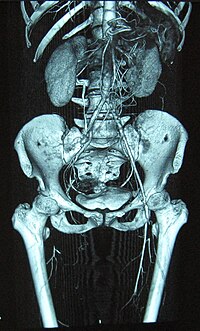
Photo from wikipedia
W e sincerely thank Dr. Knox for his thoughtful and insightful comments regarding a possible relationship between cigarette (and/or marijuana) smoking and acute posterior multifocal placoid pigment epitheliopathy (APMPPE)-associated cerebral… Click to show full abstract
W e sincerely thank Dr. Knox for his thoughtful and insightful comments regarding a possible relationship between cigarette (and/or marijuana) smoking and acute posterior multifocal placoid pigment epitheliopathy (APMPPE)-associated cerebral vasculitis and between Buerger disease and APMPPE, including a thorough historical account and informative case summaries to illustrate his assertion. We agree with Dr. Knox regarding a possible association between smoking and APMPPE, particularly in cases of APMPPE that are complicated by cerebral vasculitis. In our case report of APMPPE associated with fatal cerebral vasculitis, we made sure to mention the positive history of cigarette smoking for that very reason. However, we did not touch on this point in the discussion, and accordingly, we are grateful to Dr. Knox for raising this issue. In previous reports of APMPPE, even with cerebral vasculitis/neurologic manifestations present, the clinical history has typically focused on the presence or absence of antecedent viral illness but often does not mention a positive vs negative history of smoking (1), perhaps because many authors may have assumed that this was not clinically relevant. At least some cases (2), however, have been reported in which it was specifically mentioned that there was no history of cigarette smoking, recreational drug use, or alcohol use. On the other hand, it is of interest that Dr. Knox unearthed retroactively from de Vries et al a positive history of smoking in the case they had reported in 2006 (previously referenced). As Dr. Knox also noted, the case report by Van Zyl et al (3) also mentioned a history of cigarette smoking in their patient. We fully agree with Dr. Knox that any patient with APMPPE should be questioned regarding smoking history, and if answering in the affirmative, should of course be counseled as to the importance of cessation. Likewise, it is prudent for authors reporting any future cases of APMPPE to include specific mention of smoking history in their publications. This consistency in reporting is obviously crucial for determining whether a genuine association between smoking and APMPPE exists, and if so, how strong this association may be. Buerger disease (thromboangiitis obliterans) is a nonatherosclerotic inflammatory, vaso-occlusive/obliterative disease most commonly affecting small-sized and mediumsized vessels of the distal extremities (4). However, cerebrovascular involvement is also seen in a minority of patients (up to 18% in some series (5), but only 0.5% in one series of 1700 patients (6)); likewise, involvement of visceral organs, potentially including multiorgan involvement, may be present in a minority of cases (7,8). The cerebrovascular component of Buerger disease that is sometimes seen (also known as cerebrovascular thromboangiitis obliterans) is the subject of Dr. Knox's letter. As to Dr. Knox's assertion that cerebrovascular Buerger disease and APMPPE-associated cerebral vasculitis are one and the same disease entity, we hesitate to agree with this point both from a clinical perspective and especially from a histopathologic perspective. From a clinical perspective, we concede that both entities are most commonly seen in relatively young adults (younger than 45–50 years), and also, both Buerger disease and APMPPE-associated cerebral vasculitis have a gender predilection for men (whereas APMPPE without neurologic manifestations has no gender predilection). On the other hand, although a current or past history of smoking is regarded by most authors as being a requirement for the diagnosis of Buerger disease, there have been at least some cases of APMPPE-associated cerebral vasculitis reported in nonsmokers, as already noted above. Second, regarding infectious triggers, APMPPE is commonly associated with an antecedent viral illness (adenovirus), and associations with rubeola (measles) and mycobacterial infection have also been reported, whereas the infectious triggers reported to be possibly associated with Buerger disease are gramnegative bacteria (Rickettsia and Porphyromonas gingivalis) (9). Third, the clinical ocular manifestations of APMPPE have been reported in association with various other autoimmune diseases (e.g., Wegener granulomatosis, systemic lupus erythematosus, erythema nodosum (3), sarcoidosis, psoriatic arthritis, etc.), whereas there has been no analogous association reported between Buerger disease and other autoimmune diseases. In fact, the presence of any identifiable autoimmune disease is generally regarded as an exclusion criterion for the diagnosis of Buerger disease (8). Moreover, the histopathology of these 2 disease entities does differ, based on reports to date. As we described in our report, vasculitis associated with APMPPE is characterized by granulomatous and lymphocytic infiltration of the vessel wall but not acute inflammation. By contrast, Buerger disease (in the acute phase) exhibits as its hallmark feature an inflammatory infiltrate within the thrombus itself, especially with polymorphonuclear leukocytes, possibly with microabscess formation. Giant cells may also be present, but again classically within the thrombus itself, whereas there is typically relatively less inflammation within the vessel wall (4). With the one entity being bereft of the acute inflammatory features that are classic in the other and with the Departments of Ophthalmology and Visual Sciences, Washington University in St. Louis, St. Louis, Missouri; Department of Pathology, Washington University in St. Louis, St. Louis, Missouri; and Departments of Ophthalmology and Visual Sciences, Washington University in St. Louis, St. Louis, Missouri
Journal Title: Journal of Neuro-Ophthalmology
Year Published: 2020
Link to full text (if available)
Share on Social Media: Sign Up to like & get
recommendations!